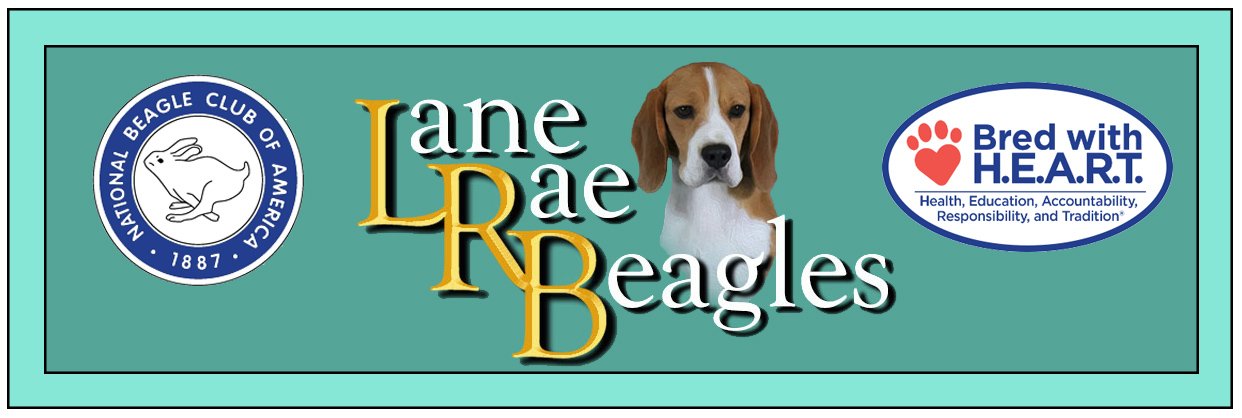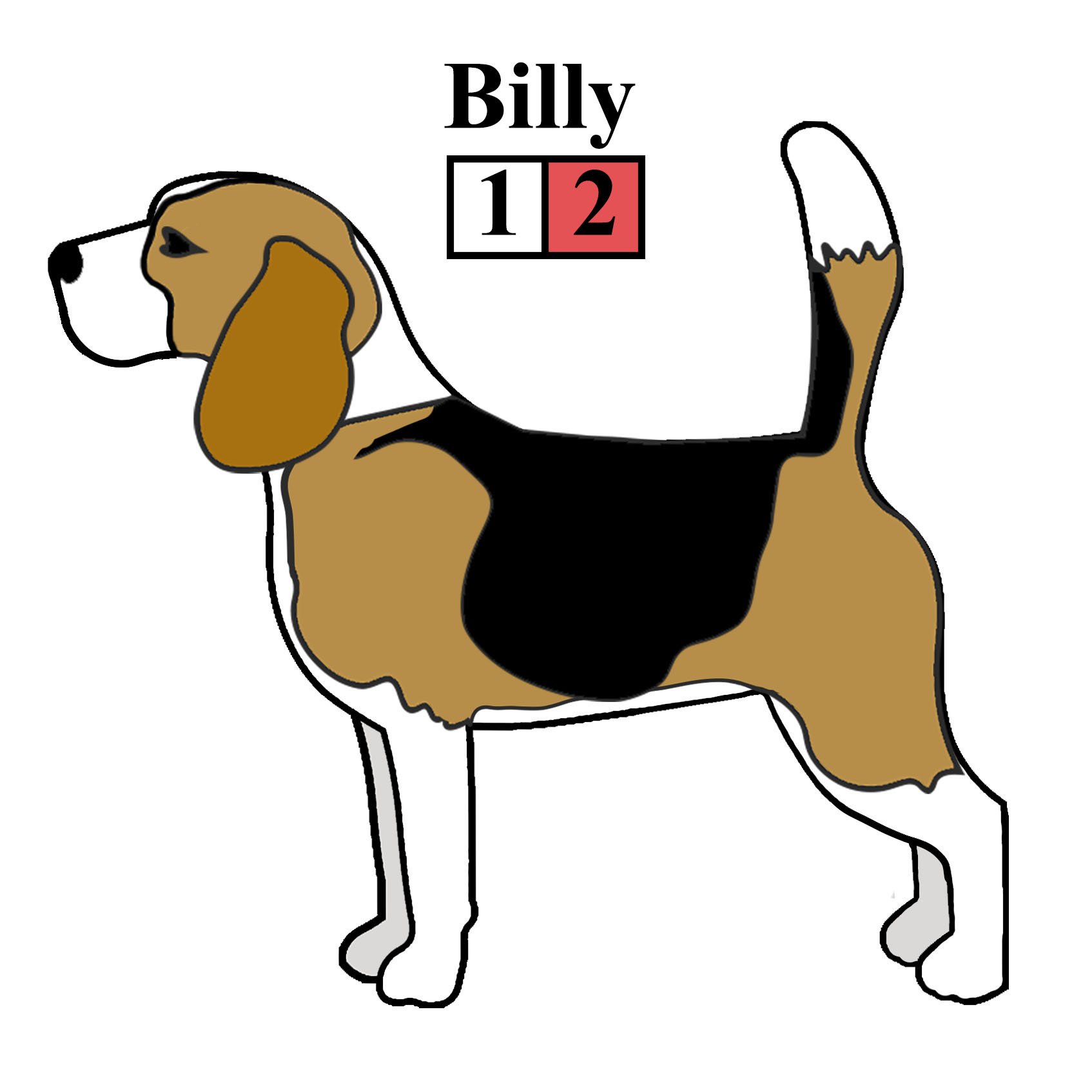OUR
BREEDING PHILOSOPHY
Understanding Breeding Practices - Outcrosses, Line Breeding and Inbreeding
No matter how you look at it, all forms of breeding are risky. Through education, experience and selective breeding Lane Rae Beagles strives to produce the best quality dogs possible in all areas. My breeding stock solidly adheres to the AKC Breed Standard, we prove our quality consistently through health testing and competitions. We never allow a dog that is physically or mentally unstable to ever contribute to our program. Strict guidelines are what keep us on track and our line strong and thriving.
Please remember there are NO lines that are fully clear of genetic issues. If a breeder tells you that they do not have issues in their line they have either not been carefully documenting results, do not stand behind the quality of their offspring or they are simply being dishonest with you. You find this mostly in breeders that are only interested in making money and do not honestly care about the puppies they produce or the health of their breed.
To be a truly successful breeder you are playing a constant game of genetic chess. A delicate balance of keeping the desirable traits of the breed and discarding the undesirable ones through selective breeding in your program. You often pick up what you are looking for paired with unknown traits you do not want. It’s hard work!
Outcrossing - is the breeding of two unrelated dogs together which can produce both hybrid vigor and outbreeding depression. This would require no related ancestors within four generations in a pedigree. With any line of dogs produced for a specific reason, such as showing or field work, most dogs will be related within at least a few generations and so it is very difficult to find a worthy dog that is unrelated for breeding. To find an unrelated dog you must go overseas, use backyard bred dogs (dogs that have no purpose and generally poorly bred) or specifically search for dogs that are not related and bred in other venues and still be what you feel will benefit your program. They say that outcrossing produces unreliable results, but I have had outstanding good luck with outcrosses, and still practice this method today.
Statistics used to say that outbred puppies were healthier, but now it is known that outcrossing has exactly the same outcome concerning health as linebreeding. Outcrossing produces a large variation in offspring and usually introduces a higher number of possible inherited diseases, where line breeding reduces the number of inherited diseases produced with a higher possible incidents if breeding stock is not health tested. I can only explain this by saying, the more dogs that are unrelated the better chance you are bringing in a new issue. The more related dogs in the pedigree the more concentrated specific issues will be. Usually “the devil you know” is the better road to take if your line is otherwise sound and health tested.
Inbreeding - is the breeding of two closely related dogs such as the breeding of father to daughter or brother to sister. This type of extreme breeding should never be used, in our opinion, because the consequences can be very dangerous. Though there are other reasons for reduced litter numbers, the only health issue actually caused by repeated and tight inbreeding is the reduction of the number or puppies produced, which is called inbreeding suppression. Inbreeding itself does not directly produce genetic health issues. The genetic health issues (mutations) we are dealing with today are from mutations produced sometimes hundreds or thousands of generations in the past. Genetic issues can be produced at a higher rate however when the dog(s) you are repeating in your pedigree (inbreeding on) carry a health issue that is not able to be detected by test5ing. In that situation you will be compounding the chance you will produce a puppy with that issue by a much higher rate, and so your chances are higher.
Line Breeding - Line breeding is a less extreme form of inbreeding. A line breeding can be as close as a half brother to half sister or grandfather to granddaughter but more often, and preferred in most instances, it is the same dog repeated in a multiple generation pedigree. This form of breeding used to “fix” or “set” desirable traits, including genetic health, but can also bring with it undesirable ones as well so inbreeding should only be done when you have deep faith and knowledge about the line or dog you are compounding. This especially applies to mental and physical health. While line breeding is less likely to cause problems in the first generation than true inbreeding, over time, line breeding can reduce the genetic diversity of a breeding program and be just as detrimental and so caution must be used. Lane Rae Beagles very rarely uses close Line Breeding. We prefer more distant Line Breeding.
Breeding Examples (these genetic issue does not actually exist) - Let’s say there is a dog named “Bobby” that has won many prestigious dog shows, is a lovely dog, great personality, sweet disposition and is what most breeders are looking for in a stud to sire litters. Breeders will want to use him, and later, probably breed his relatives together to “set” his type or attributes.
Sadly, Bobby carries a genetic issue that can not be detected by any health testing. Let’s call this genetic issue “Spinners Syndrome”. Spinners Syndrome will cause the Beagle to circle constantly to the left but only shows up between the age of 3 and 5 years. This can be a very disabling condition, and means that he should never be bred to a female that is also a carrier of the issue. Since there is no test for Spinners Syndrome there is no way to know it is there or what females he can be bred to safely.
Below you see “Bobby” and the boxes indicate his genetics (if tests were available). Box #1 shows that Bobby presents himself as normal, or showing no signs of Spinners Syndrome. Box #2 shows that he is actually a carrier of Spinners Syndrome and the condition is hidden but he could produce it in his puppies. This is called a “recessive” trait.
Most of the females that Bobby is bred to do not carry Spinners Syndrome, and so statistically, in the 99 litters and 495 puppies he has produced, all of the puppies are healthy and normal. However, 20 of these puppies carry (are recessive for) Spinners Syndrome, just like Bobby is.
One of the puppies that carries Spinners Syndrome, Let’s call her “Lucy”, is below and the boxes indicate her genetics (if tests were available). Box #1 shows that Lucy presents herself as normal, or showing no signs of Spinners Syndrome. Box #2 shows that she is actually a carrier of the condition (is recessive/hidden), just like Bobby.
Lucy has proven her quality and her owners have selected a half brother, Lets call him “Billy”, as her mate. Billy is also a son of Bobby and another outstanding example of the Beagle breed. This breeding is being completed to hopefully retain the quality seen in Bobby, Lucy and Billy. They are hoping to reproduce all of the traits they love and “set” the type, but Spinners Syndrome is lurking there and the breeders do not know it! Lucy is also a carrier!
4 lovely puppies resulted from the breeding of Lucy to Billy and they all seem to be normal and healthy! They are exactly what they hoped to produce from this pairing. They are gentle, smart, happy, eager to please and lovely! They hope that one of these puppies will be another well know success for their kennel. But, Puppy 1 is affected with Spinners Syndrome, which won’t show up until it is 3-5 years of age and if it is chosen to reproduce this issue would possibly show up after litters have already been born.
+
=
You can see from this example above -
Puppy 1 is affected with Spinners Syndrome.
Puppy 2 does not have or carry Spinners Syndrome.
Puppy 3 does not have Spinners Syndrome but it does carry it (is recessive).
Puppy 4 does not have or carry Spinners Syndrome.
6 years after Bobby began breeding, breeders have recognized that Spinners Syndrome is an issue and suspect that Bobby COULD be the cause. At this point he is seen numerous times in pedigrees all over the world, sometimes appearing several times in one pedigree.
The problem keeps compounding until Spinners Syndrome is a sadly a fairly common occurrence in Beagle litters. This is all because this one issue could not be detected by testing, and because Bobby was a popular and frequently used sire (also known as popular sire syndrome). Breeding to a sire that improves your program is a good thing, but sometimes there are things lurking that are undetectable. Caution, and a bit of detective work, should always be taken when considering a dog that is repeated in a pedigree and there is still always a chance an issue can pop up.
Let’s now consider an outcrossed (unrelated) pedigree of Bobby and Sally, who is a carrier of “Big Ear” Syndrome. (factious) Big Ear Syndrome causes Beagle puppies to be born with excessively big ears that become infected and injured easily. If Bobby, who carries Spinners Syndrome, is bred to Sally, an unrelated female that carries Big Ear Syndrome, their breeding will not produce any puppies with Spinners Syndrome or Big Ear Syndrome. They will be totally healthy! BUT ~ Now you have two issues lurking!
+
=
You can see from this example above -
Puppy 1 does not have or carry either Spinners Syndrome or Big Ear Syndrome.
Puppy 2 does not have or carry Spinners Syndrome. It does not have Big Ear Syndrome but it does carry it (is recessive).
Puppy 3 does not have Spinners Syndrome but it does carry it (is recessive). It does not have or carry Big Ear Syndrome.
Puppy 4 does not have Spinners Syndrome or Big Ear Syndrome but it does carry (is recessive) for both.













